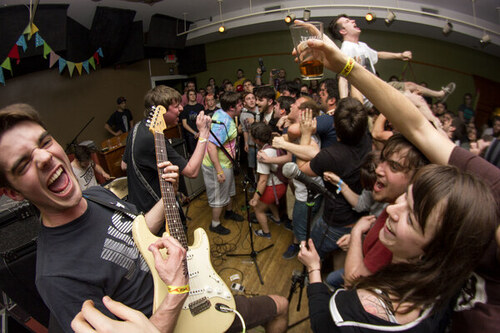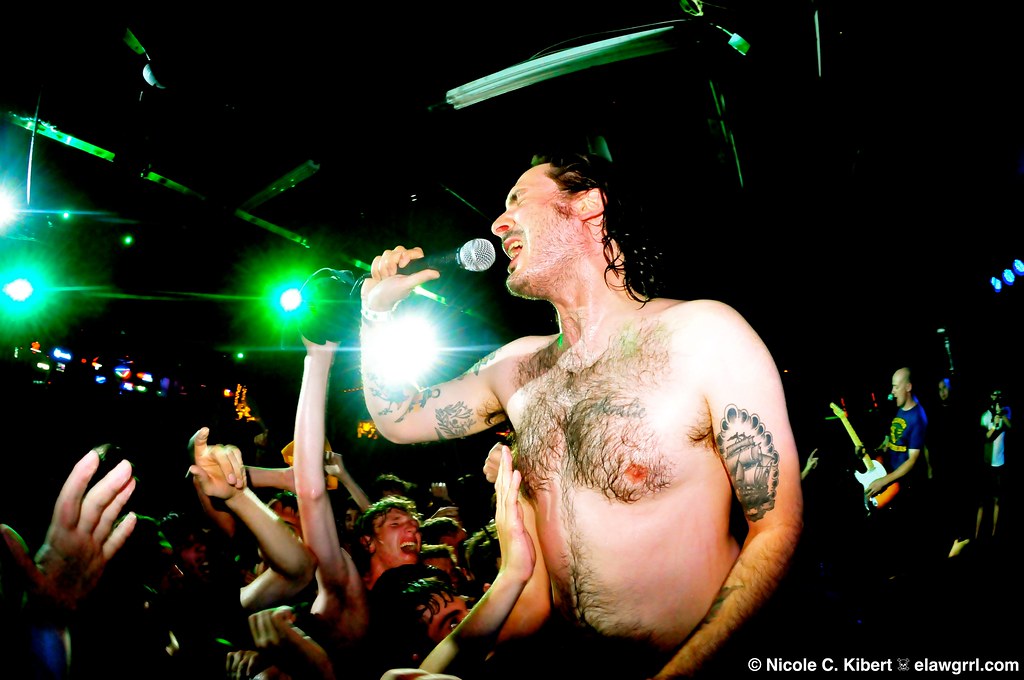I heard people nitpick the definition of midwest emo long before I began listening to the twinkly, mathy indie-emo that most consider to be actual midwest emo.
For every pretentious boyfriend I’ve had who’s corrected me when I slipped up and put Mom Jeans into the midwest emo category, there are 100 other people on Reddit telling a well-meaning user that no, Joyce Manor is not real emo.
Second-Wave Emo
To understand what midwest emo is, and what emo is on its own, we have to go back in time to its origins. Emo is typically defined as rock that has connections to hardcore and post-hardcore, with emotional lyrics and emotive delivery of these lyrics– simply put, emotive hardcore.
Midwest emo, in its first iteration, is considered the “second wave” of emo. What set midwest emo apart from just emo was its unconventional delivery– the lyrics were often more deeply personal (one could say ‘vulnerable’ or ‘raw’) and the guitars differed from the hard and heavy guitars of hardcore, leading to more “twinkly” guitar riffs.
“Twinkly,” in this case, refers to the melodies one may hear in midwest emo music that mostly deals with arpeggios (that is, notes of a chord being played in either an ascending or descending order). Twinkle emo is closely related– although not the same– as math rock, which many of us are familiar with via bands such as American Football or Cap’n Jazz.
Cap’n Jazz’s music introduced an interesting transition to the emo scene in the 1990s– they kept the punk of their predecessors, whilst also innovating, whether that be in their guitars, vocals, lyrics, or rhythmic complexity. The shift in the 90s encouraged musicians in the DIY scene (DIY meaning independently created, continued– not related to a corporate label or production company) to experiment and to push outside the bounds of punk and hardcore with what they had, which, in the case of most DIY musicians, was not much.
Midwest emo was, of course, named because of its development in the Midwestern US, but is not exclusive to any region.
The Midwest Emo Revival

Midwest emo died a bit after the 90s faded and was widely replaced by bands many considered to be “mall emo,” such as My Chemical Romance, Fall Out Boy, Pierce the Veil, even Green Day and Blink-182.
In the 2010s, there was– you guessed it– a sort of revival of the once-lost subgenre of midwest emo. People still differentiate bands that are widely considered to be midwest emo into two categories: punk-influenced, or influenced by the original midwest emo groups of the 1990s.
Bands such as The World Is a Beautiful Place & I Am No Longer Afraid to Die and Algernon Calwallader are categorized as “real emo,” whereas bands the validity of bands such as Title Fight, Joyce Manor, Citizen, Modern Baseball, and The Hotelier is often questioned.
“Real Emo”
This article would be incomplete and purposeless without a discussion of the narrative the scene has built around “real emo” and the pretentious and elitist attitude that is so often encountered.
A note that I think many miss when discussing what is actually emo versus what is, I suppose, just a group of posers, is that music evolves. Genres evolve. If we compare 90s hip-hop to today’s hip-hop, they look incredibly different from each other, but people still consider them to be the same genre. Even subgenres change over time. If music was static, it wouldn’t still be being made. We haven’t solved music, and we can’t, so the only possible route is to continue to grow and change and discover more from the genres we love.
On the blog You Don’t Need Maps, author Ellie writes in a piece called “A BRIEF HISTORY OF THE EMO TWINKLE” that although the “indie-rock-ified style of emo that dominates internet DIY is about as far removed from the sonics and aesthetics of […] the style of emo that formed a huge part of the hardcore scene all those years ago as the mall-emo bands of the 2000s,” most of what we consider emo today, even in a broad or general sense, has roots in the same area.
The roots are important to how we classify “real emo,” because bands have gone very different directions from each other whilst still maintaining their origins in the same place, and that is how one can classify sub-genre.
Furthermore, if the sanctity of “real emo” is as important as the guys in the five-panel hats who are drinking PBRs at the back of the Jeff Rosenstock show may try to make it out to be, then breaking the genre would be an issue, but it’s not.
Breaking genre, experimentation, and innovation are how we get new music– in fact, it’s how the original midwest emo subgenre began.
Whether your crowd is smearing black eyeliner over their faces like raccoons or clipping their keys to their pants, or both, the elitist structure that the scene has somehow developed does not benefit anyone. Gatekeeping and hierarchies are what DIY is supposed to destroy– and thus it doesn’t make sense to find ourselves gatekeeping DIY, or emo, or really any punk or hardcore-influenced music.
When I saw Drug Church at Motorco in 2021, frontman Patrick Kindlon said to the crowd before a pit formed, “Nobody concerned about being cool, just have a good f—ing time, OK?” Although many would scoff if I even attempted to classify Drug Church as emo, I think Kindlon’s words are extremely important to the scene and what it stands for.
— bel$

